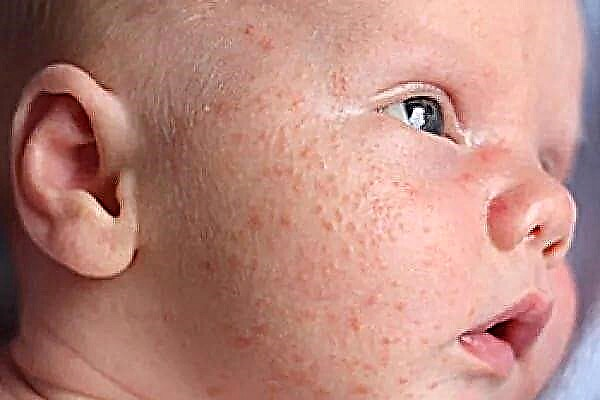Often parents are interested in the age at which a child can be given beets. This especially worries those moms and dads, whose children suffer from constipation. Beets are famous for the fact that they normalize the digestive system, making it easier for not only children, but also adults.

Baby
Benefits of beets for baby nutrition
The root vegetable is usually valued precisely for its effect on the infant's digestive system:
- Eliminates the development of constipation, with regular use in accordance with permitted standards;
- Reduces flatulence;
- Normalizes intestinal peristalsis.
Beetroot has a mild effect, thanks to plant fibers or coarse fiber. It helps the growth of beneficial microflora that populates the intestines, which prevents the development of constipation and dysbiosis, which also leads to stool disorder.
Also, eating a vegetable stimulates the formation of red blood cells, which has a beneficial effect on brain development. It will also relieve thyroid problems, if necessary, protect the liver and support its functioning.
Nutritional value
Beetroot is a low-calorie product, but it can increase the appetite, which makes its introduction into the diet indispensable for young women. It is rich in fiber and carbohydrates, contains practically no fats, and a small amount of proteins.
Beets are rich in vitamins, including group B, which are necessary for the development of the nervous system, reduce nervous excitability, and support digestion. The root vegetable contains iron, which is easily absorbed by the child and reduces the risk of anemia. It contains calcium, magnesium, phosphorus and iodine.
Note! The vegetable contains antioxidants that will help strengthen the baby's immunity, increase his resistance to various diseases. Pectin, which is part of beets, removes toxins from the body.
How to give beets to babies
Up to a year, it is better to give the baby beets after heat treatment. It can be stewed, boiled or baked. This, of course, will deprive the vegetable of some of its nutrients and vitamins, but it will also get rid of nitrates, to which the baby's digestive system can react badly.
The juice
When you can give a baby beetroot juice depends on how many months the root crop itself was introduced into complementary foods. Only when the baby learns the vegetable and gets used to it, you can move on to the juice. You should not rush to add it to the diet, it is even better to give it to a one-year-old child. Not only because it is made from raw vegetables. The juice itself has a specific taste and is difficult to digest. You need to dilute it with water or another juice, for example, apple juice. Its use can lead to irritation of the digestive tract mucosa.

Beet juice
Note! Beet juice should be no more than a third of the total volume of the drink offered to the baby.
No need to be upset if your baby doesn't like it. Children are more likely to eat boiled vegetable puree, the benefits of which are much higher.
Boiled
The most popular heat treatment method is cooking. You need to use as little water as possible so that it slightly covers the root crop. So boiled beets will lose less nutrients.
Other methods
Beets for babies can also be stewed or baked. It is washed and peeled in advance. When baking, the root vegetable is cut into small slices and sent to the oven, lightly sprinkled with oil. Before stewing, grate raw beets on a coarse grater and put them in a pan along with other vegetables familiar to the baby. At the same time, you do not need to close the lid; nitrates come out of the vegetable along with the steam. You can soak it in cool water for half an hour in advance.
Note! Beets are not given to babies separately, so you can cook them with other products.
To give the finished dish the desired consistency, it is most convenient to use a blender. You can always add water if necessary.
When to introduce beets into complementary foods
The timing of the introduction of beets into complementary foods depends on the timing of the baby's acquaintance with adult food. There are several important rules to remember:
- For children who are breastfed, foods are added to the diet after 6 months. Previously, there was no need for this, mother's milk gives the growing body everything it needs. A 6-month-old baby is already ready to get acquainted with adult food, only breastfeeding is not enough for him for full growth and development;
- "Artificial" babies receive complementary foods a little earlier - at 4-4.5 months;
- The first to appear in the diet are vegetables, zucchini, broccoli, cauliflower. After a while, pumpkin, potatoes and carrots are introduced;
- Dairy-free cereals are added next. It is recommended to start with corn, buckwheat and oatmeal.

Porridge in complementary foods
Later, at the age of 8-9 months, you can give your child beets, when he gets acquainted with new products and gets used to them. If the baby is prone to developing allergies, including to foods, it is worth giving up beets for up to a year. Despite its invaluable benefits, its use can indeed lead to negative reactions.
Earlier entry is allowed if indicated by a doctor. If, for example, a baby has chronic constipation, and massage and gymnastics do not help him cope with it. Enemas and other bowel stimulants will not work for the child, but the gentle action of the root vegetable can ease the situation.
How to cook beets
The choice of a root vegetable for cooking a dish should be approached by a baby with responsibility:
- Small vegetables are preferred. Beets tend to absorb substances used for fertilization from the soil. The larger the fruit, the more likely it is to contain pesticides and other harmful additives;
- The color should be dark red, bright, without white streaks.
It is better to take vegetables from your own garden or from trusted farms that guarantee the quality of the product.
The beets must be washed thoroughly and a sponge can be used to completely remove dirt and soil. Then cut off the top in the place where the tops were. It is there that most nitrates accumulate. There is no need to cut off the peel, it contains a lot of nutrients, so it is better to carefully remove it after cooking.
Pour water into a saucepan so that it slightly covers the vegetable, and put on medium heat. As soon as the beets are free to pierce with a knife to the middle, they are ready.
Note! To minimize the amount of harmful substances, you can boil the vegetable for 10-15 minutes, then change the water and send the container back to the fire.
Cooking time depends on the age of the root crop. Young vegetables are ready in 30-40 minutes, while the peel is removed from them without effort and even without a knife. Usually it takes 1-1.5 hours.

Boiled beets
After the beets are cooked, they need to be cooled, peeled and chopped. It is convenient to use a blender. If the puree seems too thick, you can add a little water.
Remember! Beets must be combined with other products; it is not recommended to give them separately to babies, especially as a first feeding.
The juice is made from raw root vegetables. You need to clean it and use a juicer. If it is not there, then you can grate the vegetable and then squeeze it out with gauze. It is imperative to dilute with boiled water and only then offer a drop to the baby.
Beet feeding rates for babies
Beets can be added to the child's complementary foods when he tasted green vegetables, got acquainted with potatoes and carrots. If the baby has not experienced any allergic reactions, then it is time to think about expanding the diet. It is better to forget about beets, at least up to a year, if the baby has a stool disorder, in particular, he is prone to diarrhea. The root vegetable will only aggravate the situation by increasing intestinal peristalsis. Therefore, this complementary food is more suitable for babies suffering from constipation.
You need to remember the rules for introducing any new product:
- The kid must be healthy, vigorous and active. It is desirable that he recently did not tolerate infectious diseases and did not participate in vaccinations;
- The first serving should not exceed half a teaspoon. Beets must be mixed with another product. Moreover, it should not exceed 30% of the total volume of the dish;
- Be sure to give the crumbs a vegetable in the morning, this is necessary in case of an allergic reaction, in order to provide assistance in a timely manner.
Complementary feeding for the baby is a little stress. Therefore, it cannot be superimposed on other experiences of the infant. It is worth protecting his fragile nervous system.
How often to give
For children under one year old, beets are not recommended to be given more than once a week. The same applies to root vegetable juice. Although beets are useful, and in some cases irreplaceable, often a child under one year old should not eat them.
Number
For the first time, the baby will try half a teaspoon of beetroot puree added to other foods. So, on the second day, when he tastes it, you can increase the portion. This is done only if the child does not develop rashes or other negative reactions. If they are present, you should immediately discard the product and consult a doctor. Self-medication, especially for children under one year old, is dangerous, can lead to irreparable consequences.
Usually on the 7th day of complementary feeding with a new product, its volume is brought to the permitted rate. For beets, this is 25-30 grams. Be sure to remember that it should be exactly a third of the dish, no more.

Beetroot puree
After a year, the baby will already try soups, salads, as for mashed potatoes, it is better for babies to limit themselves to thirty grams a day, once a week. Do not give your baby beets as much as he eats, this can negatively affect digestion.
Note! After 12 months, the serving size can be increased to 50 grams. Until the age of 7, it is not recommended to offer a child more than 100 grams of product per day.
What can be combined with
Beets go well with vegetables and fruits. So it is added to potatoes, carrots, zucchini. You can puree the apple by diluting it with water to make it less thick. Until a year, it is not recommended to add salt to dishes, as well as add sugar to them. You can pour in a few drops of vegetable oil.
When the baby begins to cope with the pieces, you can gradually transfer him to the common table. Many children love borscht, which is prepared without cabbage, if the crumb does not like it too much. If it is supposed to give soup with beef, then it is necessary to boil it longer so that it becomes soft, and the baby copes with it. This is provided that it is already in the diet.
Beetroot puree is also combined with various cereals. It can be added to barley, pearl barley, wheat, rice and buckwheat. In this case, you need to cook them in water. This will diversify the taste of dishes well-known to the baby and give them a zest.
When adding beetroot puree to other foods, it is necessary that they are familiar to the baby. Only when he has mastered them separately is their mixing allowed.
The famous children's doctor Komarovsky strongly recommends not to force-feed children, but only to acquaint them with a variety of products and flavor combinations up to a year. The child should be interested in food, eat it with pleasure. The basis of the diet for the first 12 months is breast milk or an adapted formula.
Possible problems when feeding beets
Beetroot is considered an allergenic product, so it is not recommended to introduce it into the diet first and generally add it to dishes if the baby is prone to skin rashes or diarrhea.
When eating a root vegetable, a baby may experience the following undesirable symptoms:
- Rash, mainly on the cheeks, it may itch;
- Nausea or vomiting, frequent regurgitation;
- Lachrymation, redness of the eyes;
- Sneezing and nasal congestion;
- Decreased appetite;
- Diarrhea;
- Quincke's edema.
Beets can be poisoned if you buy them from an unverified seller. When it contains a lot of nitrates and pesticides, the baby's body can react to them. However, proper heat treatment will rid the product of them, so its use becomes safe. It is better not to make juice from beets bought in an unfamiliar place.
Note! In young children, the use of root vegetables can lead to a decrease in blood pressure, so you need to carefully monitor the child's well-being.
In any case, if the behavior of the crumbs changes, symptoms of poisoning or allergies appear, a doctor's consultation is required. Only a specialist will be able to prescribe the correct treatment, relieving symptoms and alleviating the baby's condition. If the baby begins to choke, and there is a suspicion of swelling of the mucous membranes, you need to immediately call an ambulance.
Be sure to remove the beets from the complementary foods and forget about their return for a while. Perhaps the child will outgrow and after 1.5 years will normally accept a useful root crop.

Grown up child eating beets
To understand when you can give beets to babies, you need to find out the peculiarities of assimilation of the vegetable and how to cook it correctly. It is not advised to be the first to introduce it into complementary foods, it can lead to problems with digestion and provoke allergies. Compliance with all the recommendations will avoid problems, and beets in the diet will improve not only digestion, but also strengthen the immune system and the nervous system of the crumbs. There are many dishes that can be prepared from a healthy root vegetable for the delight of not only a child, but also adults.



